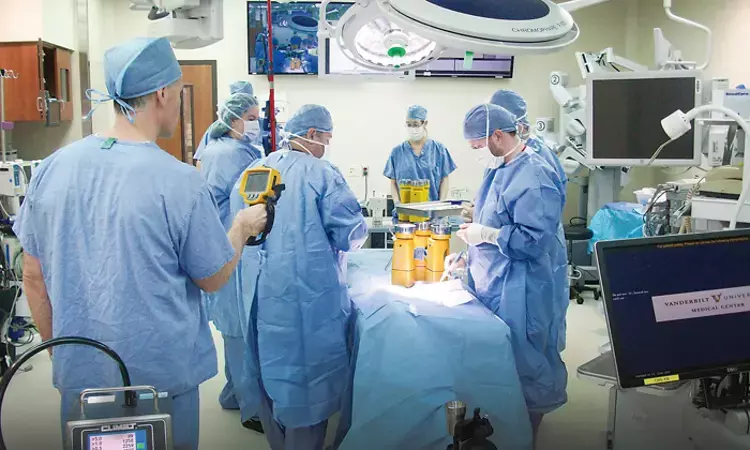- Home
- Medical news & Guidelines
- Anesthesiology
- Cardiology and CTVS
- Critical Care
- Dentistry
- Dermatology
- Diabetes and Endocrinology
- ENT
- Gastroenterology
- Medicine
- Nephrology
- Neurology
- Obstretics-Gynaecology
- Oncology
- Ophthalmology
- Orthopaedics
- Pediatrics-Neonatology
- Psychiatry
- Pulmonology
- Radiology
- Surgery
- Urology
- Laboratory Medicine
- Diet
- Nursing
- Paramedical
- Physiotherapy
- Health news
- Fact Check
- Bone Health Fact Check
- Brain Health Fact Check
- Cancer Related Fact Check
- Child Care Fact Check
- Dental and oral health fact check
- Diabetes and metabolic health fact check
- Diet and Nutrition Fact Check
- Eye and ENT Care Fact Check
- Fitness fact check
- Gut health fact check
- Heart health fact check
- Kidney health fact check
- Medical education fact check
- Men's health fact check
- Respiratory fact check
- Skin and hair care fact check
- Vaccine and Immunization fact check
- Women's health fact check
- AYUSH
- State News
- Andaman and Nicobar Islands
- Andhra Pradesh
- Arunachal Pradesh
- Assam
- Bihar
- Chandigarh
- Chattisgarh
- Dadra and Nagar Haveli
- Daman and Diu
- Delhi
- Goa
- Gujarat
- Haryana
- Himachal Pradesh
- Jammu & Kashmir
- Jharkhand
- Karnataka
- Kerala
- Ladakh
- Lakshadweep
- Madhya Pradesh
- Maharashtra
- Manipur
- Meghalaya
- Mizoram
- Nagaland
- Odisha
- Puducherry
- Punjab
- Rajasthan
- Sikkim
- Tamil Nadu
- Telangana
- Tripura
- Uttar Pradesh
- Uttrakhand
- West Bengal
- Medical Education
- Industry
High Air Pressure in Surgery Room may reduce risk of Surgical Site Infection

Operating-room (OR) heating, ventilation, and air-conditioning (HVAC) systems play an important role in the reduction of airborne bacterial colony-forming units. In a recent study, researchers have reported that by maintaining air pressures in operating and postoperative rooms exceeding bacterial-deactivation thresholds reduces Incisional surgical site infections (SSIs) rates following surgery. The study findings were published in the World Journal of Surgery on January 15, 2021.
High air pressure deactivates bacteria and is utilized for commercial food preservation, assuring microbiologically safe pharmaceuticals and sanitizing instruments. Laminar flow ventilation systems reduce OR bacterial counts, but their ability to lower surgical site infection (SSI) rates in joint replacement procedures is controversial and the research on utilizing air pressure deactivation thresholds in surgical and postoperative rooms to reduce rates of SSIs is lacking. Therefore, Byron L. Crape and colleagues conducted a study to evaluate the effectiveness of air pressure deactivation thresholds in surgical and postoperative rooms in reducing the rates of SSIs.
It was a case-control study of 801 CABG patients. Researchers compared 128 SSI cases with 673 controls from January 1, 2006, through March 31, 2009, in Yerevan, Armenia. The major outcome assessed was SSI rates. They determined patient and surgery characteristics, air pressure measurements and seasons as an independent variable for analysis. They used the novel threshold regression analysis to determine potential air pressure bacterial deactivation thresholds. They also used a multivariate logistic regression model for adjusting confounders.
The overall bacterial deactivation air pressure threshold was 694.2 mmHg. Researchers noted individual deactivation thresholds for Staphylococcus epidermidis (threshold = 694.2 mmHg) and Escherichia coli (threshold = 689.2) showed similar patterns. Upon multivariate logistic regression, they found that the air pressure above the deactivation threshold was highly protective against SSIs with adjOR = 0.27. They also found female sex, adjOR = 2.12, diabetes, adjOR = 2.61 and longer time on the ventilator, adjOdds = 1.01 as other SSI risk factors.
The authors concluded, "Maintaining air pressures in operating and postoperative rooms exceeding bacterial-deactivation thresholds might substantially reduce SSI rates following surgery. Further research should identify specific bacterial-deactivation air pressure thresholds in surgical and postoperative rooms to reduce SSI rates, especially for drug-resistant bacteria".
For further information:
https://link.springer.com/article/10.1007/s00268-020-05932-1
Medical Dialogues Bureau consists of a team of passionate medical/scientific writers, led by doctors and healthcare researchers. Our team efforts to bring you updated and timely news about the important happenings of the medical and healthcare sector. Our editorial team can be reached at editorial@medicaldialogues.in.
Dr Kamal Kant Kohli-MBBS, DTCD- a chest specialist with more than 30 years of practice and a flair for writing clinical articles, Dr Kamal Kant Kohli joined Medical Dialogues as a Chief Editor of Medical News. Besides writing articles, as an editor, he proofreads and verifies all the medical content published on Medical Dialogues including those coming from journals, studies,medical conferences,guidelines etc. Email: drkohli@medicaldialogues.in. Contact no. 011-43720751


